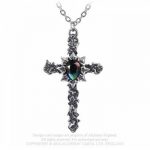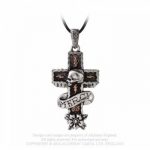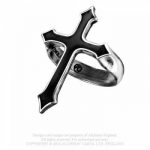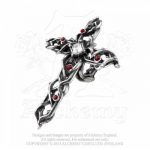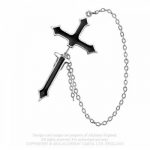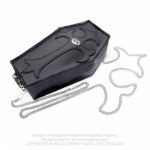In the Confessional with The Sinister Minister
 You may be familiar with Peter Laws via his regular column reviewing horror films for the Fortean Times. Or perhaps his grisly thriller novels – Purged and Unleashed. What distinguishes Peter from most other horror critics and crime novelists is that he’s also an ordained Baptist priest – an unusual combination that’s earnt him the nickname the Sinister Minister.
You may be familiar with Peter Laws via his regular column reviewing horror films for the Fortean Times. Or perhaps his grisly thriller novels – Purged and Unleashed. What distinguishes Peter from most other horror critics and crime novelists is that he’s also an ordained Baptist priest – an unusual combination that’s earnt him the nickname the Sinister Minister.
His most recent work is a non-fiction book entitled The Frighteners. In it, Peter investigates why we – and he himself – are drawn to the gory and horrific. It’s a fascinating subject with some relevance to us here at Alchemy – in case you hadn’t noticed we like all things dark and spooky here too! So we despatched our unholiest resident horror fan, Gavin Baddeley, to find out what the Sinister Minister had discovered…
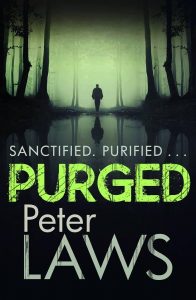 GB How did the idea for the book come about? Was there a Eureka moment, or had the the notion of a book exploring the appeal of the macabre been brewing for a long time?
GB How did the idea for the book come about? Was there a Eureka moment, or had the the notion of a book exploring the appeal of the macabre been brewing for a long time?
PL The question had been brewing for a long time. All my life, to be honest, since I’ve been fascinated by the dark and mysterious my whole life. But there was a Eureka moment that prompted me to start a serious quest to answer that question. I was walking the snowy streets of a Saxon village in Transylvania. I was there partly for a 40th birthday treat and was also writing an article on the spooky folklore of the region for The Fortean Times magazine. As I walked through the streets, wolves were howling in the hills and some wild dogs appeared and circled me for a while. It was spooky and scary and I could guess that many wouldn’t have liked it at all. But to me, it felt amazing. I went back to my room that night and lay in bed, wondering why I found such things exciting. I decided that when I returned home, I’d start researching it as a potential book idea. Thankfully a non-fiction publisher loved the idea and I got started on 18 months of wild and wonderful research, filled with all sorts of spooky and crazy experiences.
GB How does your day job as a minister impact upon your sinister passion for horror, and vice versa?
PL Actually, these days I’m a full time author, so writing has become my day job – I write spooky crime thrillers as well as non-fiction. But I’m still ordained so I do move around and lead services on Sundays. I’ve found that my passion for faith and fright sit alongside each other well. I’ve always found that the Gothic and macabre prompted me to ponder big questions. Indeed, horror is the only genre that really takes the supernatural seriously. I tend to think that regardless of our beliefs, we’re all just human beings trying to thrive in life, but we’re also coming to terms with a frightening and disturbing world. I find that dark culture helps me ponder and reflect on these fears, without anybody getting hurt. Plus the Bible hardly shies away from dark imagery. Despite what fundamentalists might have you think, that book is packed with radical, hopeful ideas, but it’s got its fair share of death, despair and even a few ‘allegorical’ monsters here and there. So if the Bible is willing to use the darker shades in its palette of communication, then I figure we can too.
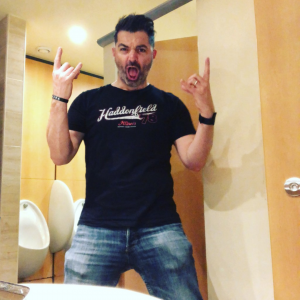 GB What’s the most extreme reaction you’ve experienced when fellow Christians have discovered you’re a horror fan, or again vice versa?
GB What’s the most extreme reaction you’ve experienced when fellow Christians have discovered you’re a horror fan, or again vice versa?
PL On the whole, fellow Christians have been amazingly open-minded and supportive – the church is more progressive and intelligent place than many seem to think – but sadly the hardcore ‘God Hates Fags’ types tend to get the most press. Hence, us Christians are often seen as party-poopers at best, or more often, judgemental hypocrites. Yet many Christians I know are more open-minded than you might think. But yes, there have still been some churchgoers who really struggle with my interest. For example, I was booked to speak at a church once, but then they saw my website and a video I’d done praising the movie The Witch. They cancelled me after that, though they actually did it in a very thoughtful way and explained some deeper pastoral reasons why I might be risky for them. One other time, I was interviewed by a Christian radio show host. This was a small scale, local channel. Anyway, I learned later that she’d been asking her friends to pray for her, because she thought I might be possessed. I wasn’t surprised, to be honest. She though Harry Potter was demonic! She’d have passed out if she’d seen my movie collection!
GB Alchemy caters to those of us who like to literally wear their passion for Gothic and macabre – do you have any clothing, jewellery or the like that would announce your tastes to fellow fans?
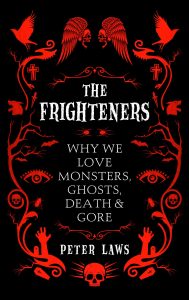 PL I don’t dress in an obvious Gothic way, but I do parade my morbid interests in a more subtle fashion. For example, I like to wear T-Shirts that feature logos from companies that are featured in horror films. So for example, the KAB radio station logo from John Carpenter’s The Fog or the evil toy company Silver Shamrock from Halloween III; the electrical company from Jaws 2; the university logo from Jack Torrance’s old university in The Shining. They look like normal T-Shirts to anybody else, but horror geeks spot them straight away! I especially like a recent T-Shirt I picked up, that advertises Nilbog Milk – that’s the poison the Goblins use to murder and cannibalise folks in the notorious horror sequel Troll 2. Oh, and I just picked up a Cramp Crystal Lake baseball cap – the summer camp where Jason Voorhees murders a bunch of teenagers in the Friday the 13th films. I don’t avoid obvious horror outfits because of shame or anything – it’s just a matter of taste. I quite like things that aren’t obvious, and can creep under the radar.
PL I don’t dress in an obvious Gothic way, but I do parade my morbid interests in a more subtle fashion. For example, I like to wear T-Shirts that feature logos from companies that are featured in horror films. So for example, the KAB radio station logo from John Carpenter’s The Fog or the evil toy company Silver Shamrock from Halloween III; the electrical company from Jaws 2; the university logo from Jack Torrance’s old university in The Shining. They look like normal T-Shirts to anybody else, but horror geeks spot them straight away! I especially like a recent T-Shirt I picked up, that advertises Nilbog Milk – that’s the poison the Goblins use to murder and cannibalise folks in the notorious horror sequel Troll 2. Oh, and I just picked up a Cramp Crystal Lake baseball cap – the summer camp where Jason Voorhees murders a bunch of teenagers in the Friday the 13th films. I don’t avoid obvious horror outfits because of shame or anything – it’s just a matter of taste. I quite like things that aren’t obvious, and can creep under the radar.
Your question reminds me of a funny incident. As a teenager I bought a white T-shirt which had a full, three-dimensional axe embedded in the blood soaked chest area. It was a pretty amazing effect and I remember I once came out of a cinema after seeing Poltergeist II. I thought it’d be funny to scream, run into the road and collapse as if I’d been recently attacked. But a lovely old elderly couple came over, panicking I was dead. I leapt up, full of apologies and let them flick the latex axe for proof.
Oh, and I do wear a wristband with symbols on it that help explain why I’m a Christian, in case anybody ever asks. One of those symbols is a cross which, let’s face it, is as macabre a symbol as it gets. It always amuses me how many people wear a crucifix as a form of gentle comfort, forgetting that it’s one of the most brutal forms of execution imaginable. Imagine buying a little set of noose earrings for your non-Goth mum’s birthday or a bracelet with electric chairs dangling for a child’s baptism. We forget how hardcore the cross symbol is – heck, you get it on tea towels! Ha.
GB Fans seem to embrace horror and the Gothic in a total way in which, say, fans of action flicks or Westerns don’t seem to. Why do you think this is? Might it be because horror fans are still outcasts somehow?
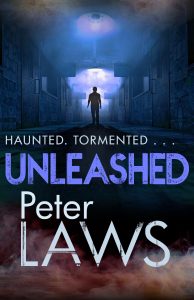 PL I agree. Horror – along with science fiction and fantasy – seems to inspire massive and deep devotion. I think one explanation for that is that many fans can trace their love of the genre back to childhood. I’ve interviewed lots of people about the love of horror, and I’ve lost count of how many discovered it at a young age – often related to a treasured memory. ‘I used to watch Hammer Horror with my granddad,’ or ‘My parents let me stay up to watch Salem’s Lot’ or ‘I was terrified by Dr. Who.’ These experiences were scary and even felt forbidden – which made them thrilling and left us feeling fully alive. I keep finding this nostalgia element, be it conscious or subconscious, being a key feature in many people’s love of the macabre. It means that ironically, many of us find great comfort and reassurance in scary, dark material. It may sound crazy, but I can watch a balls out horror like The Evil Dead, which is filled with gore and demons – and yet scary films of that era can be a calming influence in times of stress – because it unlocks memories of who I was when I first watched it – a young boy, without the stress of jobs and mortgages and the real life horrors of the world.
PL I agree. Horror – along with science fiction and fantasy – seems to inspire massive and deep devotion. I think one explanation for that is that many fans can trace their love of the genre back to childhood. I’ve interviewed lots of people about the love of horror, and I’ve lost count of how many discovered it at a young age – often related to a treasured memory. ‘I used to watch Hammer Horror with my granddad,’ or ‘My parents let me stay up to watch Salem’s Lot’ or ‘I was terrified by Dr. Who.’ These experiences were scary and even felt forbidden – which made them thrilling and left us feeling fully alive. I keep finding this nostalgia element, be it conscious or subconscious, being a key feature in many people’s love of the macabre. It means that ironically, many of us find great comfort and reassurance in scary, dark material. It may sound crazy, but I can watch a balls out horror like The Evil Dead, which is filled with gore and demons – and yet scary films of that era can be a calming influence in times of stress – because it unlocks memories of who I was when I first watched it – a young boy, without the stress of jobs and mortgages and the real life horrors of the world.
In my book, I chat to a woman who calls herself a vampire. She regularly drinks genuine blood, and traces it back to an early memory of cutting herself and finding the blood both beautiful and delicious. As she grew up, she knew this interest was odd, by most people’s standards – but then she found the world of horror where those sorts of fascinations weren’t freaky – they were empowering. Horror movies and Gothic culture present a world in which morbid interest is 100% relevant, and desirable. The ignorant, the sceptical, they tend to die first in horror films – but those who appreciate the shadows and monsters have more of a chance. And yes, being fascinated by the macabre can make a person feel freakish, so it’s not wonder we’re drawn to fictional worlds, where that interest is legitimised. The same dynamic happens in fan communities, where we remind each other that we’re not alone in our interests. One of the main points of my book is to reassure people that being fascinated by the dark side – including death and violence – is a perfectly normal, I would even argue, necessary trait of human culture.
GB Your book is both for those who share your love of horror, but also those who struggle to understand why anybody might like anything Gothic or horrific. I think maybe some people try and downplay their interest in order to avoid being judged, while others wear it as a badge of pride, even a symbol of rebellion – what’s your take on this?
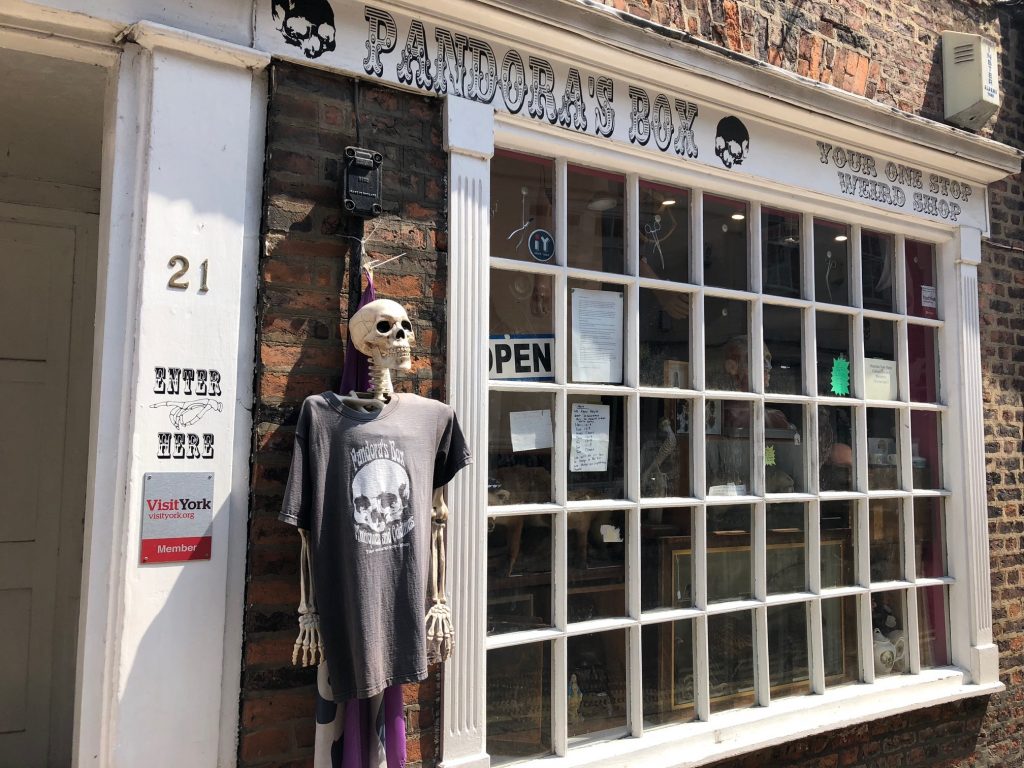 PL I’ve certainly had experience of both extremes. For example, in the book I devote an entire chapter asking why culture would be drawn to serial killers, and I particularly focus on the Murderabilia industry. That’s where people buy genuine items that are associated with the worlds most savage killers. For example, I held a lock of Charles Manson’s hair in my hands, which you can buy by the strand to wear around your neck in a vial – £40 when I was there. Pretty controversial stuff, and the dealers who sell these – in a high street shop in York, called Pandora’s Box – were very open about their motivations – they had a love of collecting, but also a deep desire to shock and act rebellious in some way. For some of us, testing the taste of those around us is part of our DNA. Maybe we do it as part of an elaborate psychological quest to seek people who understand and accept the most extreme version of ourselves, or maybe we just get a kick out of disgusting other people.
PL I’ve certainly had experience of both extremes. For example, in the book I devote an entire chapter asking why culture would be drawn to serial killers, and I particularly focus on the Murderabilia industry. That’s where people buy genuine items that are associated with the worlds most savage killers. For example, I held a lock of Charles Manson’s hair in my hands, which you can buy by the strand to wear around your neck in a vial – £40 when I was there. Pretty controversial stuff, and the dealers who sell these – in a high street shop in York, called Pandora’s Box – were very open about their motivations – they had a love of collecting, but also a deep desire to shock and act rebellious in some way. For some of us, testing the taste of those around us is part of our DNA. Maybe we do it as part of an elaborate psychological quest to seek people who understand and accept the most extreme version of ourselves, or maybe we just get a kick out of disgusting other people.
But I’ve also met people who downplay their morbid interest through fear of being labelled – for example, I’ve had little old ladies in church Bible studies guiltily admit that they enjoyed the scene in the book of Judges, where a guy gets a tent peg rammed through his head. I actually think there will be many in the church who are drawn to the morbid and macabre, and yet feel it isn’t healthy or Godly to do explore it – especially when they’re told it’s Satanic, like I was. For those people, this can actually create some significant inner turmoil – wanting to enjoy a scary movie, let’s say, but feeling like they’re in a cosmic battle with the devil. I think people should chill about about morbid interest and see it as a normal part of human curiosity – especially when the Bible itself is so willing to use the macabre as a lens through which to find meaning in life.
For more information, check out Peter’s website https://www.peterlaws.co.uk/
We have no shortage of cruciform designs here at Alchemy, whether you wish to express your personal spiritual beliefs in a stylish fashion, revere it as a macabre Gothic symbol, or a bit of both! For those looking for a pendant, for example, there is the Ivy Cross (P804), and the Mercy Cross (ULP45). The In Memoriam (R145) is a classic, cruciform Victorian Gothic ring, while The Thorny Cross handspan ring (R192) makes a more flamboyant statement. The Impalare Cross (E280) is an eye-catching conversation piece you wear on your ear, while our popular Coffin Purse (LG6) is emblazoned with a Gothic cross.
Words by – Gavin Baddeley
www.gavinbaddeley.com

